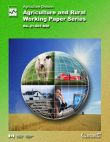Publications
Agriculture and Rural Working Paper Series
The Social Economy Across the Rural to Urban Gradient: Evidence from Registered Charities
The Social Economy Across the Rural to Urban Gradient: Evidence from Registered Charities
Archived Content
Information identified as archived is provided for reference, research or recordkeeping purposes. It is not subject to the Government of Canada Web Standards and has not been altered or updated since it was archived. Please "contact us" to request a format other than those available.

By Arthur Friesen, Rural Secretariat, Agriculture and Agri-Food Canada and Alessandro Alasia and Ray Bollman, Statistics Canada
Executive summary
Although the analysis of the social economy remains challenging due to definition and measurement issues, over the last few years there has been a major effort to understand its formal components. Recent estimates suggest that the non-profit and voluntary sector contribute to between 2.4% to 6.8% of Canada's GDP, depending on the definition used (Statistics Canada 2008a).
This paper focuses on registered charities, which are one of the main types of formal organizations within the domain of the social economy. We present a profile of registered charities across the rural to urban gradient and highlight the potential use of administrative tax filer data for further community level analysis. Our analysis is based on data from the Canada Revenue Agency, which are processed with Statistics Canada's Postal Code Conversion File (PCCF+). This classifies each registered charity to standard census geographies, in our case census subdivisions. The results are presented here by degree of rurality of the community, using the rural and small town definition of rural. Hence, our definition of rural/urban charities is based on the location of the charities and not necessarily on the geographic scope of their activities.
The results confirm some common perceptions about rural organizations involved in the social economy; but they also reveal specific peculiarities of rural charities. In addition, the results show the existing degree of diversity within rural regions, even regarding the characteristics of registered charities. The profile of rural charities in closer proximity to urban centres (i.e., strong metropolitan influenced zones) appears consistent with an image of affluence, typical of this rural space, in which charitable organizations have a less prominent role but nonetheless seem to receive more resources from the local community. In contrast, rural charities in more remote areas (i.e., moderate and weak metropolitan influenced zones) present a different profile from both urban and relatively more "affluent" rural areas.
Not surprisingly, rural charities as a whole tend to be smaller than their urban counterparts by any economic and financial measure; for instance, they typically have a smaller number of paid employees, smaller board of directors, and more volunteer directors. The number of registered charities per inhabitant increases when moving from urban to rural areas, while the economic and financial size of the charity decreases along the same scale.
Several other indicators suggest that rural charities tend to have stronger ties with their local communities in terms of program delivery. Rural charities had a slightly stronger focus on local activities relative to urban charities, although they are also slightly more likely to be governed centrally (as opposed to locally) than urban ones. Similarly, the types of fundraising activities appear also to emphasize the community ties. With respect to the focal activity of the charity, although charities established to advance religion are the most common type in both rural and urban areas, the prevalence of charities established to advance religion is particularly high in rural communities where they represent approximately half of all charities. Moreover, of all the tax receipted gifts made to rural charities, 78.1% of those gifts were received by rural religious charities.
The prevalence of funding from any level of government is similar in the budget of rural and urban charities, although the distribution of government funding tends to be concentrated in urban areas. In both rural and urban areas, charities involved in education and health care dominate both in terms of total revenue and total revenue from government sources.
- Date modified:
